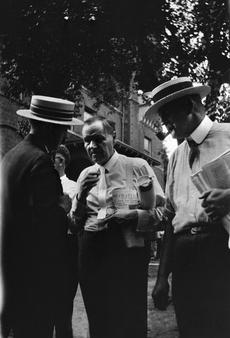
This post was co-written by Ellen Alers, Archivist, and Tammy Peters, Supervisory Archivist.
Eighty-six years have passed since John Scopes was put on trial in Dayton, Tennessee, for violating the statewide ban on teaching the theory of evolution. But a few weeks ago we heard the voice of someone who witnessed the outdoor trial proceedings on July 20, 1925. This was not a recording or an actor reading from a transcript of an oral history. It was the witness, HERSELF!
Back in July, we asked the public if they could help us identify some of the people depicted in photos in our collection of the Scopes trial. So, we were delighted when we were contacted by Martha Seeley recently. Martha Seeley, 94 (nee Cunnyngham – yes, with a “Y”), was eight years old when her hometown, Dayton, Tennessee, was transformed from a quiet southern town into the stage for the “Trial of the Century”; pitting two legal giants (Clarence Darrow—defense and William Jennings Bryan—prosecution) against one another. Initially, Martha wrote to the Archives in response to an article in the Chattanooga Times Free Press for help in identifying images from the trial in our collection (Science Service Records, Record Unit 7091), she helped note a misidentification on one (this photo on the Flickr Commons and pictured to the right, is actually Gordon McKenzie on right, not Arthur Garfield Hays), but there was more.
Her letter went on to recount how she’d been told by her mother not to leave the house because of all the strangers in town. And how her father snuck her out and she sat atop his shoulders, on the north lawn outside the courthouse, and listened to Darrow and Bryan spar on the platform. He instructed her, to “pay real close attention because you are witnessing history.” And she must have, because the account she wrote to the Archives leapt off the page.
She also enclosed a picture, taken by her sister Melrose, of herself in July of 1925 standing with her sister’s boyfriend (Steve), a telegrapher who was in town to help with the extra workload. By the way, Steve gave her a pack of gum, which she was not allowed to have, so it’s hidden behind her back (check out her right hand).

The letter and picture absolutely made our week and we really wanted to call her and express our thanks and ask for permission to write about her, but we weren’t sure she’d want to hear from us. We needn’t have worried. Thank you, Martha for including your contact information because, as you the reader may have guessed, there was more.
Over the phone, Martha continued to tell us how her mother, because of a family connection, took a “dim view” of the trial and called it a “publicity stunt”, while on the other hand, her father counseled Scopes, who was initially reluctant to participate in the test trial. She doesn’t know if her mother ever found out that her father snuck her out to witness the trial.
Just when we thought the story ended, our Research Associate, Marcel LaFollette, told us that there is a scrapbook at the National Museum of American History, compiled by Scopes’ wife, Mildred Walker Scopes in the 1960s and donated in 2008. In it are letters from Martha’s brothers, Ross and Phillip “Punk,” who played football for Scopes. Each wrote Scopes after the publication of his autobiography in 1967. “Punk” Cunnyngham wrote on April 8, 1967, “As a kid running around the court house yard with Carmack Waterhouse we tried to keep up with the WGN [Chicago radio] announcer Quin Ryan. We were fascinated by this new medium that had invaded our city. I actually felt for Mr. Bryan when Darrow began to pick him to pieces during the out-door session. Boy that Darrow was smart.” Ross Cunnyngham also recounted memories of the trial and gave updates on people Scopes would have known. He closes his March 29, 1967, letter with, “I saw you on the TODAY show from N.Y. You did well and wished you could have stayed the entire show.”
In the end, after all that, we sat back a little dazed and thought . . . without snail mail and the telephone we would never have heard Martha’s story—can’t tweet that. Connecting through letters (both Martha’s and her brothers’) and hearing voices (on the page and in the flesh) is a VERY good thing, indeed.
Produced by the Smithsonian Institution Archives. For copyright questions, please see the Terms of Use.

Leave a Comment